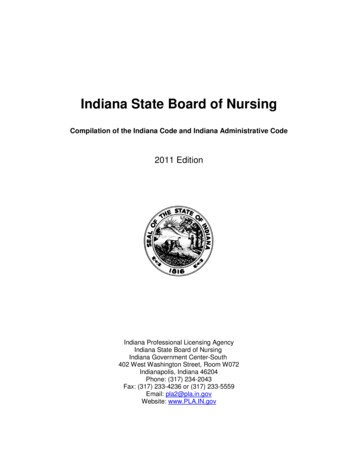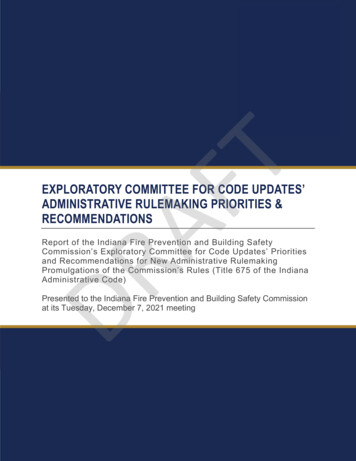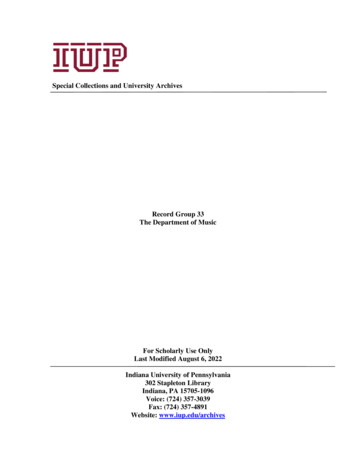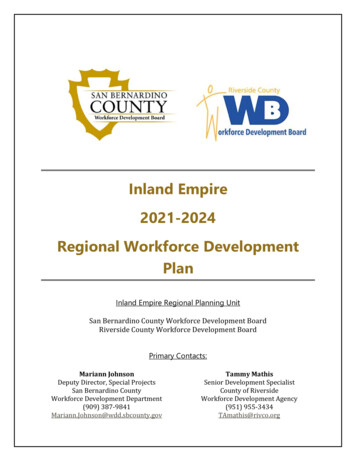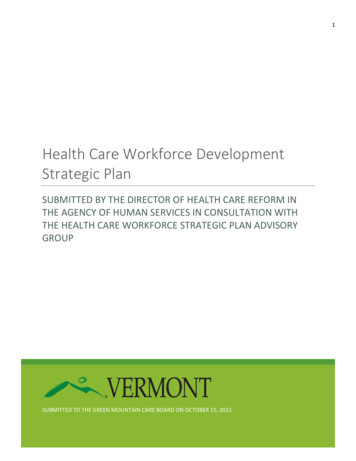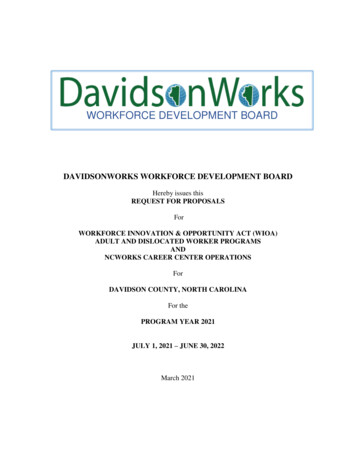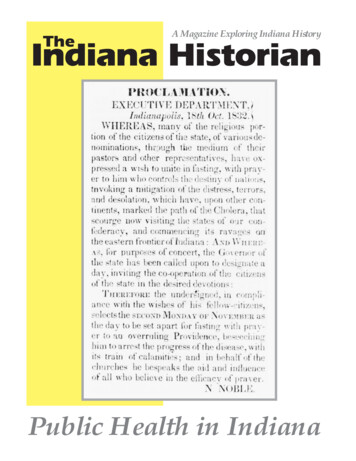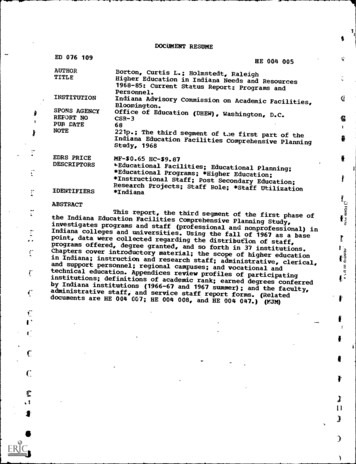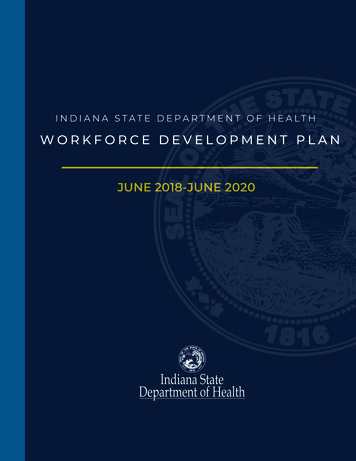
Transcription
I N D I A N A S TAT E D E PA R T M E N T O F H E A LT HWORKFORCE DEVELOPMENT PLANJUNE 2018-JUNE 2020
Table of ContentsAgency Profile .3Mission & Vision Statement .3Population Served .3Strategic Priorities .3Governance .3Organizational Structure .4Learning Culture, Adaptation and the Workforce .4Development PlanWorkforce Profile .5Workforce Policies .5Workforce Demographics .6Competencies and Educational Requirements .7Current Trainings .82018-2020 ISDH Workforce Development Goals .10Potential Barriers .15Workforce Assessment and Alignment with ISDH .16Strategic Planning Goals and Office of Public HealthPerformance Management GoalsAPPENDIX I – ISDH Organizational Chart .18APPENDIX II – Division and Office-Level Trainings .19
Agency ProfileMission & Vision StatementVision statement: A healthier and safer IndianaMission statement: To promote, protect and improve the health and safety of all Hoosiers.Population ServedThe Indiana State Department of Health (ISDH) is located in Indianapolis, Indiana, and serves the entire state.Local health departments work independently to focus on the needs of each county or municipality. Indianahas 93 local departments in 92 counties throughout the state. Indiana is a decentralized state as local healthdepartments do not report to ISDH. Rather, ISDH provides support as needed to those health departments.Indiana Fast Facts - US Census Bureau1Population Estimate (July 2017) – 6,666,818 Percent Female: 50.7% Percent Male: 49.3%Race and Hispanic Origin White alone 85.6% Black or African American 9.7% American Indian and Alaska Native alone 0.4% Asian alone 2.2% Native Hawaiian and Other Pacific Islander alone: 0.1% Two or More Races: 2.0% Hispanic or Latino: 6.8% White alone, not Hispanic or Latino: 79.6ISDH Strategic PrioritiesAccording to the 2018-2020 Agency Strategic Plan, the ISDH has identified the following strategic priorities1. Focusing on social determinants of health, specifically access to health care2. Improving the public health infrastructure, the quality and culture of health3. Improving health outcomes and reducing health disparitiesa. Reduce rates of chronic diseaseb. Address the opioid epidemicc. Improve birth outcomes and reduce infant mortalityGovernanceISDH is an executive branch agency that reports to the Governor. ISDH is advised by an Executive Boardcomprised of 11 members appointed by the Governor. They include: three (3) licensed physicians, one (1)sanitary engineer, one (1) pharmacist, one (1) dentist, one (1) veterinarian, one (1) registered nurse, one (1)hospital administrator, one (1) health facility administrator, and one (1) other person. The Executive Board isestablished by Indiana Code 16-19-2-1.
Organizational StructureIndiana State Department of Health is comprised of four commissions and nine support offices/divisions.The Commissions include: Health Care Quality and Regulatory Commission, Health and Human ServicesCommission, Public Health Protection and Laboratory Services Commission, Tobacco Prevention andCessation Commission.Support offices/divisions include: Office of Public Health Performance Management, the EpidemiologyResource Center, HIV/STD, Office of Public Affairs, Finance, Office of Legal Affairs, Healthy HoosiersFoundation, Office of Technology Compliance, and Local Health Department Outreach.The State Health Commissioner is appointed by the Governor. The State Health Commissioner overseesthe Chief Medical Officer, Deputy Commissioner and State Epidemiologist, Chief of Staff, Health and HumanServices Commissioner, and Public Health and Laboratory Services Commissioner.The Chief Medical Officer oversees the following divisions: Tobacco Prevention and Cessation and HealthEquity and Minority Wellness.The Deputy Commissioner/State Epidemiologist oversees the Office of Public Health PerformanceManagement, the Epidemiology Resource Center, and HIV/STD/Viral Hepatitis.The Chief of Staff oversees the following: Office of Public Affairs, Finance, Office of Legal Affairs, HealthyHoosiers Foundation, Office of Technology Compliance, and the Healthcare Quality and Regulatory Commission.The Healthcare Quality and Regulatory Commission includes the following divisions: Long-term Care, AcuteCare, Vital Records, Program Development and Quality Initiative, and Health Care Education and Quality.The Health and Human Services Commissioner oversees the following divisions: Women, Infants and Children;Maternal and Child Health; Children’s Special Health Care; Women’s Health; Chronic Disease; Primary Careand Rural Health; Nutrition and Physical Activity; Oral Health; Trauma and Injury Prevention; Child and FatalityReview; and the Center for Deaf and Hard of Hearing.The Public Health Protection and Laboratory Services Commissioner oversees the following divisions:Laboratories, Environmental Public Health, Food Protection, Emergency Preparedness, Lead and HealthyHomes and Immunization. (The ISDH organizational chart can be found in Appendix I)Learning Culture, Adaptation and theWorkforce Development PlanThe ISDH continues to promote and provide education opportunities for the public, medical professionals andgovernment employees. Public health practice is constantly evolving and advancing, and the ISDH remainscommitted to constantly adapting and evolving this plan and its implementation. The ISDH uses the latesttechnology to communicate and educate our workforce through web-based products, including the IndianaTrain (IN-TRAIN) Platform. ISDH is committed to keeping its staff up-to-date in fields that are advancing,including epidemiology, emergency preparedness and cultural competencies. This Workforce DevelopmentPlan is never complete but is an ongoing and evolving effort that adapts to new opportunities for the healthand wellness of the Hoosier state.
Workforce ProfileISDH’s workforce tends to be more educated than the national average. At ISDH, 77% of staff have a bachelor’sdegree or higher while the national average is 65%. However, ISDH’s staff has a high rate of turnover. Asignificant portion of staff have worked at the agency for five years or fewer. ISDH lags behind the nationalaverage in tenure from after five years at the agency.About 18% of the ISDH workforce is expected to retire in the next five years. New talent will need to berecruited as well as maintained. ISDH encourages employees to continually improve their skills, knowledgeand expertise. ISDH also encourages promotions from within the agency to create new professionalopportunities.Workforce PoliciesAll policies are found on the Indiana State Department of Health’s website at www.in.gov/isdh.Workforce DemographicsTotal Number of ISDH Staff: 904
State Employee DemographicsCategory # (%)# of State Employees: 740GenderFemale: 534Male: 206RaceHispanic or Latino: 11 (1.5%)American Indian or Alaska Native: 3 (.4%)Asian: 32 (4.3%)Black: 90 (12.2%)Hawaiian or Other Pacific Islander: 0 (0%)White: 602 (81.4%)Two or more: 2 (.3%)AgeBuilders Generation (born 1925-1964): 9Baby Boomer Generation (born 1947-1964): 304Generation X (born 1965-1979): 233Millennial Generation (born 1980-1994): 193Generation Z (born 1995-2016): 1Primary Professional Disciplines/Credentials:Executive: 3%Manager: 6%Supervisor: 15%Non-Supervisor: 76%Retention and Tenure16 years : 14%11-15 years: 9%6-10 years: 16%0-5 years: 61%Contractor DemographicsISDH FTE Contractors 164GenderFemale 97Male 31Gender Unknown 36RaceAmerican Indian or Alaska Native 1Asian 6Black or African American 13Hispanic or Latino 3Two or More Races 5White 91Race Unknown 45Age20-40 8841-60 6161-75 15
Competencies and Educational RequirementsISDH has adapted a set of skills for the broad practice of public health, which serves as the framework forISDH to understand, assess and meet the training needs of its employees. The set of skills has been adaptedfrom the Core Competencies for Public Health Professionals which was developed by the Council of Linkagesbetween Academia and Public Health Practice. These competencies are set up in three different tiers and arecomposed of eight different dimensions.Key dimensions for core competencies include: Analytical/Assessment Policy Development/Program Planning Communication Cultural Competency Community Dimensions of Practice Public Health Sciences Financial Planning and Management Leadership and Systems ThinkingThe following is a table of definitions for Core Competencies showing levels of professionalism which will beused when outlining a future implementation plan.Guidance Definitions for Core CompetenciesTier 1Front Line Staff/Entry Level: Core competencies apply to non-management publichealth professionals who carry out the day-to-day tasks of public health organizations.Responsibilities of these professionals may include data collection and analysis, fieldwork,program planning, outreach, communications, customer service and program support.Tier 2Program Management/Supervisory Level: Core competencies apply to the public healthprofessionals in program management or supervisory roles. Responsibilities of theseprofessionals may include developing, implementing and evaluating programs; supervisingstaff; establishing and maintaining community partnerships; managing timelines and workplans; making policy recommendations; and providing technical expertise.Tier 3Senior Management/Executive Level: Core competencies apply to public healthprofessionals at a senior management level and to leaders of public health organizations.These professionals typically have staff who report to them and may be responsible foroverseeing major programs or operations of the organization, setting a strategy and visionfor the organization, creating a culture of quality within the organization, and working withthe community to improve health.
Current TrainingsThe table below shows the current training expectations of all employees. These trainings are required and areconsidered during annual reviews. Other divisions and offices require a variety of trainings. These can be foundin Appendix II.TrainingWhoCompetencyAddressedFrequencyHIPAA (Health Insurance Portability andAccountability Act)All Staff, Interns,IndependentContractorsPolicyInitial HireEthicsAll staffPolicy,LeadershipAnnuallySexual HarassmentAll staff, Interns,IndependentContractorsPolicyAnnuallyPublic RecordsAll staff,contractorsPolicyBi-Annually
2018-2020 ISDH Workforce Development GoalsGoal 1: Continuously train ISDH staff toward public health core competenciesObjective 1 – Improve Leadership and Systems ThinkingStrategyDescription of materials/topicsScheduleStrategy 1 - ISDH will expand andThree, 10-12 week courses covering One course offered each quarter.improve its Leadership at All Levels more than 30 leadership topics/Offered in this order: Advanced,(LAAL) program.concepts including: communication, Intermediate and Core. Orderappreciate inquiry, authenticfrom 2018 is Q1 - Advanced,leadership, coaching, crisisQ2 - Intermediate, Q3 - Core,leadership, systems thinking,Q4 -Advanced. 2019 starts withchange management, team building Intermediate in Q1.and time managementStrategy 2 - ISDH will hold anannual leadership forum to supportthe leadership development of staffA day-long forum with guestspeakers and professionaldevelopment opportunities forparticipants focused on leadershipdevelopmentQ4 - 2018, 2019Strategy 3 - ISDH will expand andsupport a mentorship programMentorship program includes thesetopics and more: Getting Acquainted,Beyond Listening and Learning,Building Connections, EncourageDialogue and Debrief ExperiencesOn-going. Active recruitment atbi-weekly orientation (Mentees).Mentor Recruitment every threequarters aligned with AdvancedLAAL course graduation.Strategy 4 - ISDH will engagesupervisor- and manager-levelstaff in improving leadership andsystems thinking skillsMeeting topics will include: SystemsThinking, Adaptive Leadership,Quality Improvement, AgencyAlignment, Public Health BestPractices, 10 Essential Public HealthServices, Finance, etc.Bi-monthly, odd monthsStrategy 5 - ISDH will expand theProliferation and development ofuse of QI teams with a focus onLEAN and Raid improvement teams.improving internal systems. (See the Training of staff in QI practices.Performance Management & QualityImprovement Plan)Ongoing, monthlyStrategy 6 - ISDH will build internalcapacity to develop and improvestrategic planning across divisionsand commissions2018 - 2 projectsDevelopment of an inter-agencystrategic planning team that assistsdivisions, commissions and officeswith strategic planning (technicalassistance)2019 - 4 projects
Objective 2 – Improve Public Health Sciences TrainingsStrategyDescription of MaterialsScheduleStrategy 1 - ISDH will implementExcel tool tracking existing CETracked annuallya tracking mechanism of existingwithin the agencytrainings to establish a baseline ofContinuing Education (CE) offered atISDHStrategy 2 - ISDH will expandExpanded CE will include: QIMonthlyContinuing Education offeringsand LEAN practitioner training,leadership and team facilitation, 4 division or office specific trainingsStrategy 3 - ISDH will work tosystematically incorporate CEin policy and process across theagencyWork with executive staff to developan agency wide CE policy. IncludeCE in new-hire orientation andsupervisor/manager meetingsBi-weekly, monthlyObjective 3 – Improve Cultural CompetencyStrategyStrategy 1 - ISDH will train staff in,and improve competency of, publichealth cultural competenciesDescription of MaterialsCultural competency workshopscovering: cultural knowledge andcultural differences, health equitytraining, strategies for workingwith racial/ethnic populations, theprinciples of interpreter services,and discussion of four differentcultures (African American,Hispanic/Latino, Asian/PacificIslander, and American Indian/Alaskan Native)ScheduleMonthly
Goal 2: Improve organizational systems and culture to foster a positive and forward-thinkingState Health Department (culture of excellence)Objective 1 – Increase employee buy-in of the Agency mission by improving connection between individualemployee work profiles and the overall Agency mission.StrategyStrategy 1 - ISDH will develop toolsand processes to align division andsection level strategic planningwith the Agency strategic plan,performance management, andcurrent agency activities to createclear integration with Agency goalsand objectives.Description of MaterialsIdentification and implementationof a strategic planning andperformance management tool tobegin developing comprehensivealignment within the agencyStrategy 2 - ISDH will integratework profiles/performanceappraisals with public health corecompetencies and ongoing agencystrategic planningEducation of supervisors andmanagers on public health corecompetencies. Template tools andprocesses to create and updatework profiles/job descriptions toinclude core competenciesScheduleBi-monthlyBi-monthly, starting in 2019Objective 2 – Support new employees and increase new employee satisfactionStrategyDescription of MaterialsScheduleStrategy 1 - ISDH will increase andMeasurement of satisfactionBi-weeklymaintain high levels of satisfactionthrough survey tools for newamong new staff through integrated hires. Onboarding process willon-boarding and orientation.include HR, admin/buildingservices information, team-building,and introductions to qualityimprovement and leadershipprinciplesStrategy 2 - ISDH will expand andsupport the mentorship programamong new-hiresPromotion of Mentorship program(described above) at on-boarding/orientationBi-weekly
Objective 3 – Increase employee satisfactionStrategyStrategy 1 - ISDH will assessannually the satisfaction of staffto identify gaps, barriers, areas ofimprovement, and what works.Description of MaterialsPH WINS Assessment and/orculture of quality assessmentcompletedScheduleStrategy 2 - ISDH will integrate thelanguage of “public service” andattitudes related to public serviceinto the internal and externalcommunications of ISDH.Assessment of service and servantattitude of staff via surveys andfocus groups. Integration of service/public service principles in internaland external communicationsEvery 6 monthsStrategy 3 - ISDH will increaseopportunities and events fornetworking and staff enjoymentIncreased assessment of employeesatisfaction at employee eventsBi-monthlyAnnuallyObjective 4 – Increase satisfaction of supervisors and managersStrategyStrategy 1 - ISDH will specificallyengage supervisors and managersstaff in professional developmentDescription of MaterialsMeetings include: systems thinking,adaptive leadership, qualityimprovement, agency alignment,public health best practice, 10essential public health services, etc.ScheduleStrategy 2 - ISDH will assess andprovide strategies to addressorganizational cultureCulture of Quality Assessment toolAnnuallyStrategy 3 - ISDH will implementsuccession planning strategiesISDH implementation of the Stateof Indiana’s Monarch Initiative.This initiative includes specificsuccession planning strategies forstate agencies.January 2019-December 2019Bi-monthly
Goal 3 – Improve Indiana’s Public Health WorkforceObjective 1 – Support training of new public health professionalsStrategyStrategy 1 - ISDH will supportpre-public health professionalsby increasing and improving itsinternship programStrategy 2 - ISDH will supportpre-public health professionalsby increasing and improving ourengagement with post-secondarypublic health studentsDescription of MaterialsScheduleMore internships offered andmore interns placed agencywide. Inclusion of public healthcore competencies in internshipsopportunitiesPublic health students are invitedto engage with agency staff throughactivities, field-trips, job-shadowingand class presentations.General internship cycle follows3 semesters, spring (Jan-May),summer (June-August), and fall(Sept-Dec)QuarterlyObjective 2 – Support training of current public health professionalsStrategyDescription of MaterialsScheduleStrategy 1 - ISDH will increase andWebinars offered to LHDs aboutTwice-a-yearexpand trainings offered to localQI, leadership, divisional trainings,health departmentsthe annual Public Health NursesConference, and information abouttimely public health issuesStrategy 2 - ISDH will increase andexpand online and digital workforcedevelopment through the INTrainplatform.Increase divisions and offices usingINTrain platform for CE and othertrainings.Monthly
Potential BarriersISDH remains committed to sustaining and improving its highly trained workforce. However, several potential barriersmay impact the agency’s ability to close the gaps and reach the identified goals.External - Changes in state political leadershipBecause the State Health Commissioner is appointed by the Governor, changes in state political leadership maycause turnover at the executive staff level. Lack of continuity at the highest levels of leadership can create difficulty insustaining efforts or create the need to shift priorities.This Workforce Development (WFD) Plan includes strategies to address this barriers. ISDH will develop toolsand processes to align division and section level strategic planning with the agency strategic plan, performancemanagement, and current agency activities to create clear integration with agency goals and objectives. ISDH believesthat the development of succession planning tools specific to appointed leadership will improve transitions betweenadministrations and ensure awareness of critical functions.External - Large public health events/crisisUnforeseen, large-scale public health events or crises may stretch agency capacity and divert resources fromworkforce development and training.This WFD Plan includes strategies to address this barrier. ISDH will increase and expand trainings offered to localhealth departments and ISDH will increase and expand online and digital workforce development through the INTrainplatform. By increasing public health capacity state-wide ISDH will be helping increase local public health practitioners’ability to respond and assist with large-scale public health events and crises.External - Federal funding and supportISDH and the Office of Public Health Performance Management rely heavily on federal funds to complete theseworkforce development goals. Changes in the federal funding levels general support of public health activities mayimpact ability to achieve workforce development goals.The Office of Public Health Performance Management with in ISDH is working to address this barrier. They will stayabreast of federal funding conversations, recommendations, and best practices to be as competitive as possible forfederal grant dollars.Internal - High turnoverISDH has high turnover. While new staff can be an asset in creating new culture, systems and processes, turnover canalso be a potential barrier. High turnover means more resources must be used to train new staff in tier 1 competenciesrather than focusing on higher level competencies found in tiers 2 and 3.OPHPM is working on improving succession planning through the Monarch Initiative and believes that bettersuccession planning will help mitigate some negative impacts of turnover. OPHPM will also continue to investigatereasons for high turn-over, particularly with new and low-tenure staff. The reasons for the turn-over are not clear fromour data.Internal - Support from supervisors and managersISDH has identified that supervisors tend to be the most frustrated and unhappy with their work at ISDH. ISDH isfocusing significant efforts in this area to help achieve our goals. This WFD Plan has a number of strategies addressingthe needs of Supervisors. ISDH will engage supervisors and managers in professional development, provide strategiesto address organizational culture, and implement succession planning strategies. Specific focus on this level ofemployee will yield benefits for supervisor and the teams they lead.
Workforce Assessment and Alignment with ISDH Strategic PlanningGoals and Office of Public Health Performance Management(OPHPM) GoalsIn 2017, ISDH conducted a series of assessment and strategic planning processes germane to workforce development.Staff and workforce development needs were assessed using the ASTHO Public Health Workforce Interests andNeeds Survey (PHWINS) tool, agency-wide and OPHPM needs assessments, and SWOT analysis that were a part oftwo strategic planning processes. These took place in 2017. The results of these assessments and processes elevatedthree (3) key areas of focus related to Workforce Development. These were: Improving Employee Satisfaction Addressing Health Equity and Social Justice Principles Building Internal Capacity to Understand and Participate in the Creation and Implementationof Agency Strategies, Planning, Programs and ServicesEmployee Satisfaction - Addressing Supervisor-level SatisfactionFrom the PHWINS data we know that the satisfaction of supervisors lags behind both the national average and theoverall agency. For example, only 56% of supervisors somewhat/strongly agree that – “I recommend my organizationas a good place to work.” This is much lower than the overall agency (71%) and the national average (69%).Additionally, non-supervisors (80%), managers (82%) and executives (80%) say they are “somewhat/very satisfied withthe organization” while only 62% of supervisors are “somewhat or very satisfied with the organization.” Supervisorshave a major impact on their teams and on the culture of the agency. ISDH will work to improve this satisfaction rate.From our the agency strategic planning process we identified that ISDH will work to improve organizational healthand be an employer of choice by fostering a culture of organizational excellence and by working to create a moresupportive work environment.Addressing Health Equity and Social Justice PrinciplesNon-supervisors (26%) and supervisors/managers (36%) believe that incorporating “health equity and socialjustice principles into planning for programs and services” has high importance but low skill within ISDH. ISDH willincorporate these principles and skills into trainings for all staff.From our agency strategic planning process we identified specific strategies that include working to ensure the agencyconsiders the health of minority and disparate populations and working to reduce racial/ethnic disparities in infantmortality. Within the Agency OPHPM identified the goal to create an agency-wide health equity policy.Building Internal Understanding of Agency Strategies, Planning, Programs, and ServicesNon-supervisory staff expressed their highest needs in describing: How public health funding mechanisms support agency programs and services (41%), Value of an agency business plan (40%), Financial analysis methods applicable to program and service delivery (37%), Influence of internal changes on organizational practices (37%), Value of community strategic planning that results in a community health assessment or community healthimprovement plan (37%)
ISDH will implement strategies to increase the workforce’s ability to understand, describe, and eventually contribute tothese planning and organizational processes.From our agency strategic planning process we identified the strategy to strengthen internal partnerships. Within theagency, OPHPM identified four of its own goals to build internal understanding: Foster and maintain a culture of qualitywithin the agency, develop and Implement QI processes integrated into organizational practice, programs, processesand interventions, improve workforce development infrastructure, and align the agency toward a shared vision.Appendix I – Organizational ChartDr. Kristina BoxState Health CommissionerChief Medical OfficerDr. Joan DuwveTobacco Prevention& CessationMiranda SpitznagleHealth Disparities& Minority WellnessAntoniette HoltDeputy Commissioner& State EpidemiologistPam PontonesPublic HealthPerformanceEden BezyChief of StaffTrent FoxDeputy Chief of Staff& Office of PublicAffairsJeni O’MalleyHealth Care Quality &Regulatory CommissionHealth & Human ServicesCommissionPublic Health Protection &Laboratory ServicesCommissionTerry WhitsonEldon WhetstoneDr. Judy LovchikLong Term CareMatt FosterWomen, Infants &ChildrenMaternal & ChildHealthEldon WhetstoneMartha AllenChief FinancialOfficerAcute CareChildren’s SpecialHealth CareEric HawkinsAaron AtwellRandall SnyderShirley PayneHIV / STDOffice of LegalAffairsPreston BlackVital RecordsBrian CarnesChronic Disease,Primary Care & RuralHealthEpidemiologyResource CenterDennis StoverAnn AlleyScott ZarazeeProgram Dev &Quality InitiativeBurton GartenOffice of Technology& ComplianceHealth CareEducation & QualityChris MickensJan KulikHealthy HoosiersFoundationWomen’s HealthTerri LeeNutrition & PhysicalActivityLindsey BouzaTrauma & InjuryPreventionOral HealthDr. James MillerKatie HokansonChild & FatalityReviewCenter for Deaf &Hard of HearingGretchen MartinBethany Colson(Interim)Deputy Lab DirectorDr. Katlyn WainwrightEnvironmentalPublic HealthMike MettlerFood ProtectionKrista ClickEmergencyPreparednessLee ChristensonLead & HealthyHomesPaul KrievinsImmunizationsDave McCormickUpdated: 4-16-2018
Appendix II – Division and Office Level TrainingsThis table shows the current training expectations of different divisions and offices across ISDH. Depending on thetraining and program these trainings can be required for staff and can be considered during annual reviews.DivisionsStaff MembersCurrent ISDH TrainingsTrainingDurationBasic ACSBasic WritingSurveyors - HospitalsAcute CareHospital Basic 1Hospital Basic 2Community Health Centers Basic SurveyorTrainingPsychiatric Residential Treatment FacilitiesSurveyor TrainingBasic ESRDSTAR TrainingSurveyors - Hospice;ESRD; HHAESRD Annual UpdateBasic HospiceBasic HHABasic WritingICF/IIDBasic ICF/IIDBasic WritingNFPA Certified Fire Inspector 1Basic Life Safety Code CourseAbuse and NeglectNFPA 99LSCFire Safety Evaluation System/Health CareFire Safety Evaluation System/Board andCareAdvanced LSC: Sprinkler SystemsAdvanced LSC: Fire Alarm SystemsLong Term CareAll/unknownDirector of Health CareEducationTraining ManagerMDS NurseUpper Managers/SupervisorsAdvanced LSC: Building ConstructionBasic WritingBasic LTCBasic WritingInfection Control - Series of 3 CoursesDementia TrainingFoundational Investigative SkillsState Training Coordinators CourseFederal MDS/RAiState Training Coordinators CourseFederal MDS/RAIAHFSASADOC/SETIAspen Course for BeginnerAspen Course for AdvancedAnnually
Current ISDH TrainingsChronic DiseaseCenter forDeaf and Hardof HearingEducationPrimary Care/RuralHealth - Cancer ControlKnowledge Services Orientations TrainingRed Dot TrainingGW Cancer Center’sAll StaffCPR/First AidAnnuallyFERPAAnnuallyLeadership At All LevelsWomen’s HealthAll StaffFacilitation Tutor (http://www.facilitationtutor.com)Rape Prevention and Education LeadershipTraining MeetingIS-100.b Introduction to Incident CommandSystem, ICS-100Preparednessand EmergencyResponseDivisionIS-700.a, National Incident ManagementSystem (NIMS) an IntroductionAll StaffOnsite Sewage SystemsProgram/Plan ReviewProgramEnvironmentPublic HealthGeneral EnvironmentalHealth ProgramIS-200.b, ICS for Single Resource and InitialAction IncidentsIS-800.b. National Response Framework, anIntroductionIS808, Emergency Support Function (ESF) #8- Public Health Medical ServicesIOWPA Installer CertificationIOWPA Inspector CertificationMultiple Manufacturers’ CertificationsCertified Pool OperatorCertified Pool InspectorRecreational Water Illness CertificateIndoor Air QualityWater FluoridationProgramCEU to maintain Industrial Hygienist LicenseCDC Fluoridation CourseSTD 101 from www.cdc.govSTD Continuing Education from ww.cdc.govHIV/STD LHD Training: CT GC Testing for LHDHIV/STDSTD Prevention ProgramHIV/STD LHD Training: Legal Issues for LHDHIV/STD LHD Training: Lab
Agency Profile Mission & Vision Statement Vision statement: A healthier and safer Indiana Mission statement: To promote, protect and improve the health and safety of all Hoosiers. Population Served The Indiana State Department of Health (ISDH) is located in Indianapolis, Indiana, and serves the entire state.
